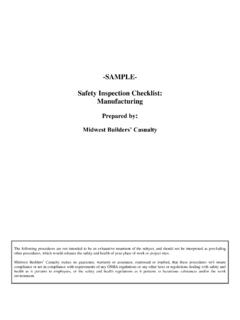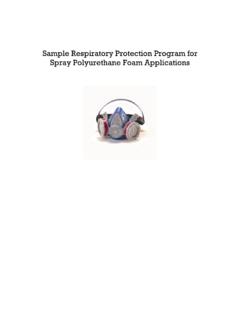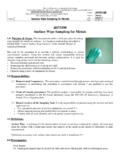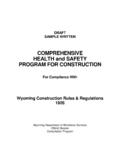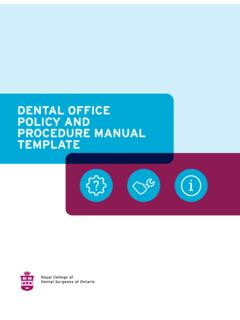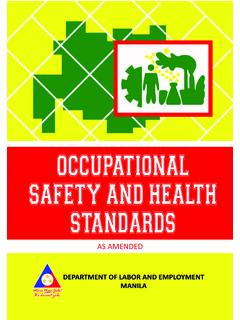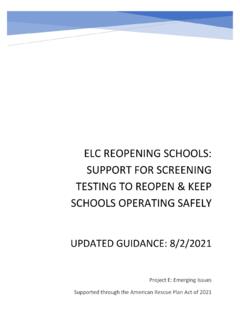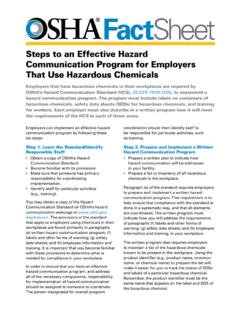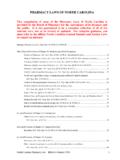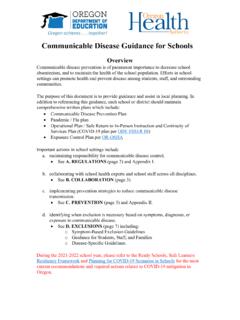Transcription of -SAMPLE- SILICA EXPOSURE PLAN – GENERAL INDUSTRY
1 1 -SAMPLE- SILICA EXPOSURE PLAN GENERAL INDUSTRY Prepared by: Midwest Builders Casualty Safety programs are most effective when they are designed to meet the specific and individual needs of each company. This safety program does not constitute a complete and comprehensive safety program. The intent of this safety program is to encourage the development of individual company specific programs by providing a sample format and suggested wording for program components. This safety program is not intended to be an exhaustive treatment of the subject, and should not be interpreted as precluding other procedures, which would enhance the safety and health of your place of work or project sites. Midwest Builders Casualty makes no guarantee, warranty or assurance, expressed or implied, that these procedures will insure compliance or are in compliance with requirements of any OSHA regulations or any other laws or regulations dealing with safety and health as it pertains to employees, or the safety and health regulations as it pertains to hazardous substances and/or the work environment.
2 2 Respirable Crystalline SILICA EXPOSURE Control Plan Tips and Considerations Applicability The sample SILICA EXPOSURE Control Plan serves as the required Written EXPOSURE Control Plan (Plan) and applies to GENERAL INDUSTRY workplaces, including concrete products, stone cutting, foundries, dental laboratories, pottery ready-mix concrete, and structural clay products containing crystalline SILICA . Hydraulic fracturing operations in the oil and gas INDUSTRY are also impacted by the rule. These activities can expose workers to SILICA dust, which can penetrate deep into the lungs and cause disabling and sometimes fatal lung diseases, including silicosis and lung cancer, as well as kidney disease. For GENERAL INDUSTRY activities that generate SILICA dust, housekeeping practices, EXPOSURE and work practice controls, medical surveillance, recordkeeping, and worker training are covered under the Occupational Safety and Health Administration s (OSHA) workplace safety rule for respirable crystalline SILICA (RCS) at 29 CFR This Plan is developed in accordance with the requirements in 29 CFR (f)(2).
3 The sample Plan does not apply to tasks that involve low exposures and where worker EXPOSURE remains below 25 micrograms per cubic meter ( g/m3) for an 8-hour time-weighted average (TWA) under foreseeable conditions. Related rules. The employer must also implement a respiratory protection program that complies with OSHA s respiratory Standard 29 CFR (b) to (d) (except 19 CFR (d)(1)(iii)) and 29 CFR (f) to (m)), an employee training and information program that complies with the Hazard Communication (HazCom) Standard 29 CFR and 29 CFR (j)(3), and maintain medical records in accordance with 29 CFR Regulatory requirements Plan elements. This sample Plan incorporates the following elements required by OSHA: A description of the tasks in the workplace that involve EXPOSURE to RCS; A description of the engineering controls, work practices, and respiratory protection used to limit employee EXPOSURE to RCS for each task; A description of the housekeeping measures used to limit employee EXPOSURE to RCS; and A description of the procedures used to restrict access to work areas, when necessary, to minimize the number of employees exposed to RCS and their level of EXPOSURE , including exposures generated by other employers or sole proprietors.
4 The employer s P lan can also include anything else deemed important about keeping employees safe from RCS at the specific worksite. Specified EXPOSURE control methods (29 CFR (c)). GENERAL INDUSTRY employers are allowed to use Table 1 of the RCS construction rule if the task performed is indistinguishable from those listed. Table 1 lists engineering and work practice controls and respiratory protection 3 for 18 specific tasks. Employers that follow Table 1 correctly are not required to measure worker EXPOSURE to SILICA and are not subject to the permissible EXPOSURE limit (PEL). PEL (29 CFR (c)). Employers must ensure that no employee is exposed to an airborne concentration of 50 g/m3. EXPOSURE assessment (29 CFR (d)). For tasks not listed on Table 1, or if employers do not fully implement the EXPOSURE controls identified, the employers must assess employee EXPOSURE if above the action level (AL) 25 g/m3 following either a performance option or scheduled monitoring option.
5 If exposures exceed the PEL, employers must repeat monitoring within 3 months. If exposures are above the AL and below the PEL, employers must repeat monitoring within 6 months. Employers must reassess as needed whenever there are changes in production, equipment, process, personnel, or work practices. Methods of analysis (29 CFR (d)(5)). All required monitoring samples must be evaluated by a laboratory that analyzes air samples for RCS in accordance with Appendix A. Employee notification (29 CFR (d)(6)). Within 15 days of completing an EXPOSURE assessment, each affected employee must be individually notified of the results of the assessment. Regulated areas (29 CFR (e)). Employers must establish a regulated area wherever an employee s EXPOSURE to airborne concentrations of RCS is, or can reasonably be expected to be, in excess of the PEL. The regulated areas must be demarcated from the rest of the workplace in a manner that minimizes the number of employees exposed to RCS within the regulated area.
6 Signs must be posted at all entrances to regulated areas with the language specified in 29 CFR (j)(2). Access to regulated areas must be limited to: Persons authorized and required by work duties to be in the area; Any person entering such an area as a designated representative of employees for the purpose of exercising the right to observe monitoring procedures; Any person authorized by the Occupational Safety and Health Act or regulations issued under it. Each employee and the employee s designated representative entering the regulated area must be provided the appropriate respiratory protection and required to use the respirator while in the area. Medical exams (29 CFR (i)). Employers must make medical surveillance available to all employees who will be required to use a respirator for 30 days or more per year. Medical examinations and procedures must be performed by a physician or other licensed health care professional (PLHCP).
7 An initial (baseline) medical examination must be performed within 30 days of initial assignment unless the employee had a similar examination within the past 3 years. The examination must consist of: A medical history, with emphasis on past, present, and anticipated EXPOSURE to RCS dust and other agents affecting the respiratory system; 4 Any history of respiratory system dysfunction, including signs and symptoms of respiratory disease, history of tuberculosis, and smoking status and history; A physical examination with special emphasis on the respiratory system; A chest X-ray (a single posteroanterior radiographic projection or radiograph of the chest at full inspiration recorded on either film (no less than 14 x 17 inches (in.) and no more than 16 x 17 in.) or digital radiography systems), interpreted and classified according to the International Labour Office (ILO) International Classification of Radiographs of Pneumoconioses by a National Institute for Occupational Safety and Health (NIOSH)-certified B Reader; A pulmonary function test to include forced vital capacity (FVC) and forced expiratory volume in 1 second (FEV1) and FEV1/FVC ratio, administered by a spirometry technician with a current certificate from a NIOSH-approved spirometry course; Testing for latent tuberculosis infection; and Any other tests deemed appropriate by the PLHCP.
8 The medical examinations that include these procedures must be conducted at least every 3 years or more frequently if recommended by the PLHCP. The examining PLHCP must have a copy of the RCS standard and the following information: A description of the employee s former, current, and anticipated duties as they relate to the employee s EXPOSURE to RCS; A description of any personal protective equipment (PPE) used, including how long the employee used or will use that PPE; and Information from medical examinations previously provided. The PLHCP will provide the employee with the results of the medical examination with a written medical report within 30 days. The PLHCP will provide the employer with a written medical opinion within in 30 days of the examination. Employers must make available medical examinations that include the aforementioned procedures at least every 3 years, or more frequently if recommended by the PLHCP.
9 Communication of hazards to employees (29 CFR (j)). Each covered employee must be trained, under OSHA s HazCom Standard (29 CFR ) on the hazards of RCS-containing products and have access to labels and safety data sheets (SDSs). The employer must ensure that at least the following hazards are addressed: cancer, lung effects, immune system effects, and kidney effects. Workers must also be trained on: Health hazards associated with EXPOSURE to RCS; Specific tasks in the workplace that could result in exposures; Specific measures the employer has implemented to protect employees from EXPOSURE , including engineering and work practice controls, and respirators to be used; Contents of the OSHA RCS rule; and Purpose and description of the medical surveillance program. Signs (29 CFR (j)(2)). Signs must be posted at all entrances to regulated areas that bear the following: DANGER RESPIRABLE CRYSTALLINE SILICA 5 MAY CAUSE CANCER CAUSES DAMAGE TO LUNGS WEAR respiratory protection IN THIS AREA AUTHORIZED PERSONNEL ONLY Recordkeeping (29 CFR (k)): Air monitoring data.
10 Accurate records of all employee EXPOSURE to RCS assessment measurements must be maintained. The record must include at least: The date of measurement for each sample that is taken; The task monitored; Sampling and analytical methods used; Number, duration, and results of samples taken; Identity of laboratory that performed analysis; Type of PPE, such as respirators, used by the employees monitored; and Name, Social Security number (SSN), and job classification of all employees represented by the monitoring, indicating which employees were actually monitored. Objective data. An accurate record of all objective data relied on must be maintained. This record must include at least: The crystalline SILICA -containing material; The source of the objective data; The testing protocol and results of testing; A description of the process, task, or activity on which the objective data were based; and Other data relevant to the process, task, activity, material, or exposures on which the data were based.


